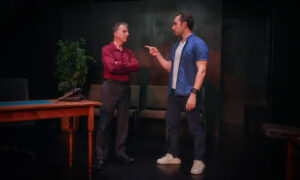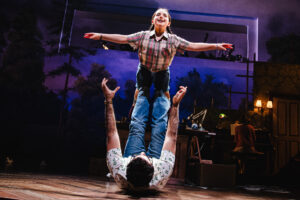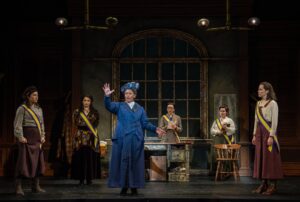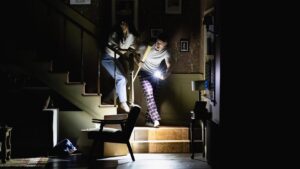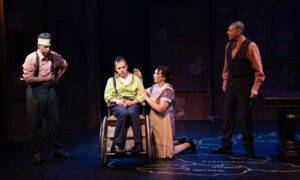In this pandemic-era, virtual theatrical production, playwright Jake Broder creates a story on the small screen that imaginatively details the brain disorder that ultimately causes the death of the protagonist, Canadian painter Anne Adams. Beginning as a two-person conversation between Anne (Lucy Davenport) and her husband, Robert (Rob Nagle), as they play Scrabble, we learn that Anne has taken a leave of absence from her job to care for their son who had been in a serious auto accident. Through Anne’s perseverance and skills, he recovers and returns to college. She announces to her husband that she has decided not to return to work, a decision that dismays Robert, as he details her personal intelligence and gifted career skills that will be lost to the community. Her choice of a pastime is to paint, a skill she has not previously demonstrated as a particular talent.
As she begins this next phase of her life, she becomes fascinated with Ravel’s Bolero, playing it as she paints. In the narrative, Ravel (Conor Duffy) appears to her, and we learn that he suffered from the same brain disorder to which she is succumbing. Their imaginary dialogue adds little to the plot, but it provides some parallel connections between the two and adds theatricality to the factual aspects of the story. Additional dialogue between Ravel’s friend Ida Rubinstein (Melissa Greenspan) and Ravel also adds to the subplot. In the cast Michael Lanahan serves as a narrator.
Broder skillfully builds his play, showcasing Anne’s increasing talent in painting as she isolates further into the world of music and art. Robert’s inability to understand what is happening to Anne causes him to enlist Dr. Bruce Miller (Leo Marks), a behavioral neurologist, to assess Anne’s health. He diagnoses her disease as primary progressive aphasia.
Davenport and Nagle are superb as they develop their marriage relationship. Nagle’s skill at providing a believable spouse with equal amounts of frustration and compassion enhances Broder’s vision for his characters. Davenport also creates a nuanced Anne, spirited but increasingly lost in her malady.
The ensemble does a fine job of bringing the story to life in the smaller virtual world, which Broder envisions someday on a larger stage with increasing emphasis on the orchestral music. The large plus in Broder’s writing is that it is far from the weepy, soapy story of a person failing from brain disease as is often the case in these narratives. It instead highlights the enriching moments of each person’s life, no matter how dire the circumstances seem to be.
Nike Doukas’ direction provides the right tone for the characters who never interact with each other physically but only live in their own space on the screen. Production designer Corwin Evans brings to life Anne’s paintings so integral to the story.
There are some moments that seem overlong toward the end of the play, but it leaves the audience with much to think about post-production. Funded by the Global Brain Health Institute as a free outreach to highlight scientific research, it makes for a worthy piece of art by Broder and his accomplished cast.


